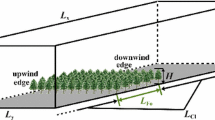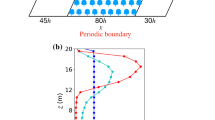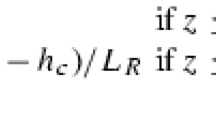Abstract
By means of large-eddy simulation, we investigate the transport of a passive scalar in the lee of forest patches under neutral atmospheric conditions in flat terrain. We found a pronounced local enhancement of scalar concentration and scalar flux in the lee zone of the forest, while further downstream above the unforested surface, the scalar transport adjusted to an equilibrium with the underlying surface conditions. By means of a term-by-term analysis of the scalar transport equation, we determined the local accumulation of the scalar to be caused by the convergence of: (1) mean and turbulent streamwise transport, (2) mean vertical transport. However, the relative importance of each transport mechanism for the accumulation process was found to depend strongly on forest density. Based on systematic parameter changes, we found concentrations to significantly increase with increasing forest density and with decreasing wind speed, while fluxes were invariant to wind speed and showed a similar relation to forest density as for the concentrations. Despite the scalar sources—ground and/or canopy sources—a local flux enhancement was present in the lee zone. Finally, we provide a first step towards localizing enhanced concentrations and fluxes at micrometeorological sites.










Similar content being viewed by others
Notes
The code can be accessed under http://palm.muk.uni-hannover.de/browser?rev=874. A documentation of the most recent PALM release 4.0, with a detailed description of PALM’s canopy model, is given by Maronga et al. (2015).
References
Armaly BF, Dursts F, Pereira JCF, Schönung B (1983) Experimental and theoretical investigation of backward-facing step flow. J Fluid Mech 127:473–496
Belcher SE, Jerram N, Hunt JCR (2003) Adjustment of a turbulent boundary layer to a canopy of roughness elements. J Fluid Mech 488:369–398
Belcher SE, Harman IN, Finnigan JJ (2012) The wind in the willows: flows in forest canopies in complex terrain. Annu Rev Fluid Mech 44:479–504
Bergen JD (1975) Air movement in a forest clearing as indicated by smoke drift. Agric Meteorol 15:165–179
Cai XM, Barlow JF, Belcher SE (2008) Dispersion and transfer of passive scalars in and above street canyons—large-eddy simulations. Atmos Environ 42:5885–5895
Cassiani M, Katul GG, Albertson JD (2008) The effects of canopy leaf area index on airflow across forest edges: large-eddy simulation and analytical results. Boundary-Layer Meteorol 126:433–460
Chan TL, Dong G, Leung CW, Cheung CS, Hung WT (2002) Validation of a two-dimensional pollutant dispersion model in an isolated street canyon. Atmos Environ 36:861–872
Detto M, Katull GG, Siqueira M, Juang JY, Stoy P (2008) The structure of turbulence near a tall forest edge: the backward-facing step flow analogy revisited. Ecol Appl 18:1420–1435
Dupont S, Brunet Y (2008) Edge flow and canopy structure: a large-eddy simulation study. Boundary-Layer Meteorol 126:51–71
Dupont S, Bonnefond JM, Irvine MR, Lamaud E, Brunet Y (2011) Long-distance edge effects in a pine forest with a deep and sparse trunk space: in situ and numerical experiments. Agric For Meteorol 151:328–344
Finnigan JJ (2000) Turbulence in plant canopies. Annu Rev Fluid Mech 32:519–571
Finnigan JJ, Belcher SE (2004) Flow over a hill covered with a plant canopy. Q J R Meteorol Soc 130:1–29
Flesch TK, Wilson JD (1999) Wind and remnant tree sway in forest cutblocks. I. Measured winds in experimental cutblocks. Agric For Meteorol 93:229–242
Foken T (2008) Micrometeorology. Springer, Berlin 306 pp
Fontan S, Katul GG, Poggi D, Manes C, Ridol L (2013) Flume experiments on turbulent flows across gaps of permeable and impermeable boundaries. Boundary-Layer Meteorol 147:21–39
Frank C, Ruck B (2008) Numerical study of the airflow over forest clearings. Forestry 81:259–277
Kanani-Sühring F, Raasch S (2015) Spatial variability of scalar concentrations and fluxes downstream of a clearing-to-forest transition: an LES study. Boundary-Layer Meteorol 155:1–27
Katul GG, Finnigan JJ, Poggi D, Leuning R, Belcher SE (2006) The influence of hilly terrain on canopy-atmosphere carbon dioxide exchange. Boundary-Layer Meteorol 118:189–216
Klaassen W, Van Breugel PB, Moors EJ, Nieveen JP (2002) Increased heat fluxes near a forest edge. Theor Appl Climatol 72:231–243
Kostas J, Soria J, Chong MS (2002) Particle image velocimetry measurements of a backward-facing step flow. Exp Fluids 33:838–853
Letzel MO, Krane M, Raasch S (2008) High resolution urban large-eddy simulation studies from street canyon to neighbourhood scale. Atmos Environ 42:8770–8784
Letzel MO, Helmke C, Ng E, An X, Lai A, Raasch S (2012) LES case study on pedestrian level ventilation in two neighbourhoods in Hong Kong. Meteorol Z 21:575–589
Markfort CD, Porté-Agel F, Stefan HG (2014) Canopy-wake dynamics and wind sheltering effects on Earth surface fluxes. Environ Fluid Mech 14:663–697
Maronga B, Gryschka M, Heinze R, Hoffmann F, Kanani-Sühring F, Keck M, Ketelsen K, Letzel MO, Sühring M, Raasch S (2015) The parallelized large-eddy simulation model (PALM) version 4.0 for atmospheric and oceanic flows: model formulation, recent developments, and future perspectives. Geosci Model Dev 8:2515–2551
Miller DR, Lin JD, Lu ZN (1991) Air flow across an alpine forest clearing: a model and field measurements. Agric For Meteorol 56:209–225
Poggi D, Katul GG (2007) Turbulent flows on forested hilly region terrain: the recirculation. Q J R Meteorol Soc 133:1027–1039
Queck R, Bernhofer C, Bienert A, Eipper T, Goldberg V, Harmansa S, Hildebrand V, Maas HG, Schlegel F, Stiller J (2015) TurbEFA: an interdisciplinary effort to investigate the turbulent flow across a forest clearing. Meteorol Z 23:637–659
Raasch S, Schröter M (2001) PALM—a large-eddy simulation model performing on massively parallel computers. Meteorol Z 10:363–372
Raupach MR, Weng WS, Carruthers DJ, Hunt JCR (1992) Temperature and humidity fields and fluxes over low hills. Q J R Meteorol Soc 118:191–225
Ross AN (2008) Large-eddy simulations of flow over forested ridges. Boundary-Layer Meteorol 128:59–76
Ross AN (2011) Scalar transport over forested hills. Boundary-Layer Meteorol 141:179–199
Ross AN, Baker TP (2013) Flow over partially forested ridges. Boundary-Layer Meteorol 146:375–392
Ross AN, Harman IN (2015) The impact of source distribution on scalar transport over forested hills. Boundary-Layer Meteorol 156:211–230
Schlegel F, Stiller J, Bienert A, Hg Maas, Queck R, Bernhofer C (2014) Large-eddy simulation study of the effects on flow of a heterogeneous forest at sub-tree resolution. Boundary-Layer Meteorol 154:27–56
Sogachev A, Leclerc MY, Zhang G, Rannik Ü, Vesala T (2008) CO\(_{2}\) fluxes near a forest edge: a numerical study. Ecol Appl 18:1454–1469
Wilson JD, Flesch TK (1999) Wind and remnant tree sway in forest cutblocks. III. A windflow model to diagnose spatial variation. Agric For Meteorol 93:259–282
Yang B, Raupach MR, Shaw RH, Paw UKT, Morse AP (2006) Large-eddy simulation of turbulent flow across a forest edge. Part I: flow statistics. Boundary-Layer Meteorol 120:377–412
Acknowledgements
This study was supported by the German Research Foundation (DFG) under Grant RA 617/23-1. All simulations were performed on the SGI Altix ICE and CRAY XC30 at The North-German Supercomputing Alliance (HLRN) in Hannover and Berlin. NCL (The NCAR Command Language (Version 6.1.2) [Software]. (2013). Boulder, Colorado: UCAR/NCAR/CISL/VETS. http://dx.doi.org/10.5065/D6WD3XH5) was used for data analysis and visualization. We appreciate the constructive comments of the two reviewers.
Author information
Authors and Affiliations
Corresponding author
Rights and permissions
About this article
Cite this article
Kanani-Sühring, F., Raasch, S. Enhanced Scalar Concentrations and Fluxes in the Lee of Forest Patches: A Large-Eddy Simulation Study. Boundary-Layer Meteorol 164, 1–17 (2017). https://doi.org/10.1007/s10546-017-0239-0
Received:
Accepted:
Published:
Issue Date:
DOI: https://doi.org/10.1007/s10546-017-0239-0




